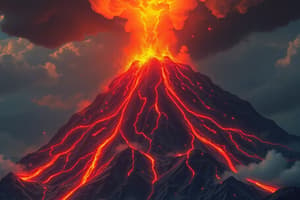Podcast
Questions and Answers
What drives magma towards Earth's surface?
What drives magma towards Earth's surface?
- Pressure from the Earth's core
- Buoyancy and pressure from gas within it (correct)
- Expansion from cooling magma
- Gravity from the surrounding rock
How are cinder cone volcanoes formed?
How are cinder cone volcanoes formed?
- By accumulation of solid lava pieces ejected during eruption (correct)
- By underwater volcanic activity
- By slow cooling of magma underground
- By lava flowing from a vent
What is the primary factor causing volcanic eruptions?
What is the primary factor causing volcanic eruptions?
- Meteor impacts
- Plate tectonics movement
- Magma pressure and weak areas in the Earth's crust (correct)
- Global warming
Where are most of the potentially active volcanoes located in the United States?
Where are most of the potentially active volcanoes located in the United States?
Which type of volcanic eruption results in the ejection of dense clouds of rock shards and gas?
Which type of volcanic eruption results in the ejection of dense clouds of rock shards and gas?
What is the distinctive characteristic of Kīlauea volcano on the Island of Hawai‘i?
What is the distinctive characteristic of Kīlauea volcano on the Island of Hawai‘i?
What is the main way volcanic terrain is formed?
What is the main way volcanic terrain is formed?
What connects the volcanic vent to the magma storage areas?
What connects the volcanic vent to the magma storage areas?
What happens when a volcano is no longer stable?
What happens when a volcano is no longer stable?
What is magma made of?
What is magma made of?
What happens when liquid magma cools?
What happens when liquid magma cools?
Why is magma lighter than the surrounding solid rock?
Why is magma lighter than the surrounding solid rock?
Flashcards are hidden until you start studying
Study Notes
Volcano Formation and Eruption
- Magma is driven towards Earth's surface by buoyancy and pressure from gas within it
- Magma forces its way upward and may break through weak areas in the Earth's crust, causing an eruption
- Eruptions can occur in various ways, including pouring out as fluid lava flows or shooting violently into the air as dense clouds of rock shards and gas
Types of Volcanoes
- Cinder cones are the simplest type of volcano, formed from small pieces of solid lava that erupt from a vent
- Cinder cones can grow up to 1,000 feet tall and accumulate in an oval shape if the wind is blowing during the eruption
Volcano Facts
- There are over 160 active and potentially active volcanoes in the United States, mostly located in Alaska and Hawaii
- Kīlauea volcano on the Island of Hawai‘i is one of the most active volcanoes on Earth, erupting almost nonstop since 1983
- There are about 1,350 potentially active volcanoes worldwide, not counting those under the oceans
- About 500 of these have erupted in the past 100 years, many of which are located around the Pacific Ocean in the "Ring of Fire"
Magma and Lava
- Magma is molten rock below the surface of the Earth that rises in volcanic vents
- Magma is made of molten rock, crystals, and dissolved gas
- Once erupted from a volcano, magma is called lava
- Lava cools and solidifies to form an igneous or magmatic rock
Studying That Suits You
Use AI to generate personalized quizzes and flashcards to suit your learning preferences.




